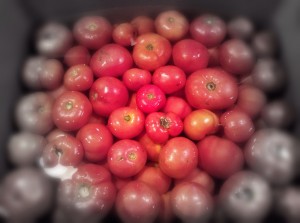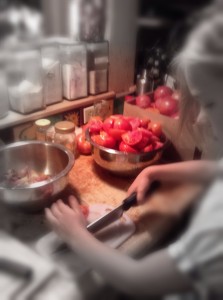It’s three in the morning. I’m standing in my kitchen, staring down 70 pounds of tomatoes and 35 pounds of onions, all awaiting their destiny in a year’s supply of tomato sauce. Lined up next to the basement stairs are 40 pounds of green beans, already chopped and neatly canned in quart jars.
August doesn’t overwhelm me like it used to. I’ve run the calculations numerous times, and the savings, year-round convenience and flavor garnered from the extra labors invested this month far outweigh the drawbacks of a few sleep-deprived nights. I’ve been up for a half hour already, and I am confident that I will have the sauce settled into a comfortable simmer by the time I start homeschool with the girls in a few hours.
My body is well acquainted with the necessary motions. Little thought is required as I fill the sink with tomatoes and line up my production course. My hands slip into the cool water and remove the wet fruit, my pairing knife glides in and around the tops, removing the stems, and my mind is free to travel.
This morning it settles on an incident from the night before. I had sat down at my computer in an attempt to answer an email from a reader asking two simple questions: “How did you take that step? How did you make a farm your life?” Before I could respond, the phone rang. Mom was paying bills, and she wasn’t happy. We’d just sent a Jersey out for processing, and she now discovered that the fee for ground beef had gone up 25 cents per pound. At the same time, she was confronted with a bill for purchasing new livestock. Presently, the price of stocker cattle is at record levels. The farm is getting pinched, and she feels we need to adjust the prices.
But a cost adjustment on ground beef isn’t easy. Unlike commodity farmers who must accept prices determined by the market, as direct marketers, we are privileged with the ability to set the fee for our product based on our expenses. That said, we have to look our customers in the eye. Changing the price of ground beef is a big deal. It doesn’t dramatically impact the small handful of our customers who have good jobs and high incomes. It impacts the vast majority of them — the ones who are either eking out an existence on the economic fringe, or the ones perceived as slightly more affluent, but who are crushed between mortgages, school debts, middle class salaries and a desire for wholesome food. Those folks can easily bypass the high end cuts it they are out of their price range. But ground beef is what folks buy when they can’t afford anything else.
Mom puts Dad on the phone with me. He and I run the numbers on the animal. We look at the live weight, the hanging weight, the yield percentages. We put that up against the price of the stockers and the cost of processing. We nudge the price up until the farm is able to net 60 cents per pound on ground beef. Averaged out with the other higher-value cuts, Sap Bush Hollow should net about $500 on this Jersey. He seems satisfied.
I am not. Each day, our farm is inching closer to a full transition, where Bob and I will completely take over the family business. As the next tomato glides through my fingers, I am tallying the un-mentioned costs that were not figured into the price of that meat: taxes, insurance, transportation, electricity, repairs and upkeep, market fees, and the biggest one of all: labor.
I drop one tomato into the bowl, then pick up a second, smiling ruefully as I consider that reader’s question. She wants to know how I took that first step. Meanwhile, I’m trying to figure out how we will keep this place running. I pause in my work with the tomatoes and shift to the stove. Bob has thoughtfully sliced the onions for me the night before, and I put them on to cook, then begin to peel the garlic Mom pulled from the garden for me. Soon, the kitchen is awake with the sizzle of onions and garlic in four enormous stock pots spread across the cooktops. Under-utilized resources, I tell myself. The trick to keeping a family farm running is capitalizing on the under-utilized resources. We’ve figured out how to capitalize on the lard, the tallow, the chicken livers, the bone broth. Is there anything else? The writing. I could step up production and marketing of the books. That could help pay the labor bill. I push that thought from my mind. Writing, after all, is not a farm product. It is something I do to honor the calling in my soul. But it is not farming.
I add the first batch of tomatoes to the pots, and I am transported back into Ruth’s kitchen, my surrogate grandmother who used to live on the farm up the road. We had a tight working space in her house. She didn’t have the luxury of counters. Food preparation was done at the kitchen table, which had to be cleared first of her crochet projects. Over the course of a day, that table was a workshop while she crocheted baby blankets and booties to sell to neighbors; it was the work station for her summer canning; the pastry board where she rolled out crusts for the pies she would make to order. Technically, like my writing, none of those things were farm products, either. But it was the canning that kept the grocery bill down, and the money from pies and baby booties that kept the siding on the barn.
I find a long wooden spoon to stir the first round of crushed tomatoes into the onions. I leave behind thoughts of Ruth’s crocheted booties and blackberry pies. My mind drifts back to that reader’s question: How did you take that first step?
I consider answering her with a historical perspective. Right now for homeschool, Saoirse is studying ancient civilizations. The agricultural revolution is glossed over in her text book with a simple paragraph that begins with “After thousands of years, Stone Age people did learn to grow their own food.” As a happy result, the book explains, early people no longer had to keep moving from one cave to the next. Feeling the topic might warrant a little more investigation, I looked up the history of agriculture on the internet. Data was pretty firm about the earliest planned sowing and harvesting, the first irrigation systems, the first use of fertilizers. But scholars cannot seem to agree on why this happened. Some have hypothesized that humans were becoming increasingly sedentary. Ha. Apparently those scholars haven’t spent much time on a working farm. Others attributed it to localized climate change; someone else suggests that it was the result of tribes exerting dominance by hosting big parties. I scroll through the list on Wikipedia until I come to a tiny mention at the bottom of the page: The Domestication Hypothesis — First, humans stayed in particular areas, then, agriculture developed.
That, in my mind, almost gets at the crux of why. Here’s what I think happened:
There was a woman. She loved her husband. But she loved her mom and dad, too, and she didn’t want to leave them behind just because she got hitched. And then there was her mother, who suddenly couldn’t bear the thought of splitting away from her daughter, of not being able to nuzzle, coo and grunt over her grand babies. And then there was the grandfather, who had killed enough wild game and found he preferred to play with younger members of his tribe. Or maybe it was a hunter who started it. Maybe he and his fellow tribesmen killed some wild sheep, then found a few baby lambs. He couldn’t bear to leave them defenseless. Or maybe it was a man, or a woman, who looked out from the cave one day and realized that the piece of ground they were standing on had such a deep hold on them, they couldn’t move.
Here’s the bottom line: I believe the answer to the question of why the agricultural revolution happened is the same answer as to how a person takes their first step in farming. It is the same answer as to why a farmer keeps raising cattle when they net only 60 cents a pound on ground beef. And it is the same answer as to why one woman would crochet baby booties and bake pies to keep the siding on the barn, or why another would dip candles, make soap, write books, or stand in her kitchen at three in the morning chopping tomatoes. The answer is….
…Love.
When you are in love, you do whatever it takes. You limit your profit to 60 cents per pound because you love your customers. You crochet booties and bake pies so you don’t have to leave the land that holds your soul. You write your books, turn sausages or dip candles so that you can keep your family together. And when August rolls around, and you have to pull yourself from your bed while it is still dark so that you can process 70 pounds of tomato sauce before your children wake up, love is the only alarm clock. And getting up is easy.
I have just finished washing and grinding the first sinkful of tomatoes. I am dumping in the second load, when I hear a creak on the stairs. Ula’s head pops around the corner. Her eyes are still sleepy, her hair is a nest of tangles. “Mommy? Why are you doing this alone? You know we can help you.” She’s right.
Seeing my smile, she scuttles down the stairs in her underpants and t-shirt, then scrambles up on a kitchen stool. Without another word she washes her hands in the sink, then goes to find a knife. At last, I am ready to answer my reader’s question. How do you take the first step to become a farmer? First, you act out of love. Then, you do whatever it takes.



It’s why we do what we do here. We love it and have done everything we can to keep doing it. You brought tears to my tired eyes today and a perfect reminder of the why….. not just the how.
thank you as always for the writing and the love you write about and share